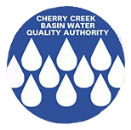2021 Annual Report on Activities
Cherry Creek Basin Water Quality Authority
Key Takeaways from Water Year 2021 (10/1/2020– 9/30/2021)
It Takes Everyone
In 2021 CCBWQA, our Member Entities, and Partners focused on meeting beneficial uses. Cherry Creek State Park has seen a record number of visitors, and Cherry Creek Reservoir continues to provide space where people enjoy recreating and connecting.
Planning for the Future
In addition to CCBWQA’s ongoing coordination, pollution reduction and reclamation projects, monitoring and analysis activities, CCBWQA strives to seek out and facilitate new and innovative opportunities to improve, protect and preserve water quality in the Basin. Several projects were initiated this year, including:
- A new weather station was installed that will better capture localized precipitation impacts, which are key to refining predictions from watershed and reservoir models;
- A Reservoir nutrient sediment sampling study was conducted to determine locations and concentrations of phosphorus stored in the Reservoir. This data, which will be reported in WY 2022, will help inform future management options;
- A vegetation removal (primarily cattails) pilot project was started in 2021 on Cottonwood Creek within Cherry Creek State Park. This work includes vegetation cutting and disposal; leaving the roots so it can regrow and regenerate (like mowing a lawn). The vegetation removal benefits water quality by preventing phosphorus and nitrogen from being carried to Cherry Creek Reservoir after the plants decay;
- CCBWQA is the proponent for a Water Quality Control Commission (WQCC) limited scope Rulemaking Hearing (RMH) for the Cherry Creek Reservoir Control Regulation 72 that will occur in April, 2022. Changes proposed are intended to make the Stormwater Permit Requirements (CR Reg 72, Section 7) more user friendly and reflect advancements in best management practices and control measure technologies.
- link Cherry Creek Weather Station
- link Sediment Sampling Study
- link Vegetation Removal Pilot Project
- link Limited Scope RMH
Why Weather Matters
Weather data shows 2021 had above-average precipitation, especially in the spring and early summer. However, July and August were dry, with precipitation measuring 87% and 40% respectively based on the historical monthly averages.
Although the Reservoir did not see any significant cyanobacteria or blue green algae blooms that required closures to public swimming, the chlorophyll-α standard was not met.
thumb_down Chlorophyll-α concentrations in the Reservoir exceeded the growing season standard, with a mean concentration of 22.2 ug/L compared with a standard of 18 ug/L.
thumb_up The Reservoir met the aquatic life standards for temperature, dissolved oxygen, and pH in WY 2021.
Point Sources
Wastewater
Wastewater Effluents in the Cherry Creek Basin have less phosphorus than background sources. Total phosphorus discharge limits for WWTFs, which average less than 50μg/L (0.05 mg/L), were less than the 176 μg/L flow weighted concentration entering the reservoir from aggregated sources (surface and groundwater inflows, precipitation) in WY 2021.
Regulated Stormwater
MS4 permits for the Cherry Creek Basin require permittees to implement water quality control measures and the work done by CCBWQA’s Members with MS4 permits contribute to maintaining water quality in the Cherry Creek.
Find Out More About Point Sources
Non-Point Sources
Pollution Abatement Project Planning
CCBWQA plans for future Pollution Abatement Projects. These planning efforts help to identify future projects, estimate water quality benefits, and inform prioritization for inclusion in the 10-year Capital Improvement Program. In 2021, CCBWQA engaged in 3 planning efforts:
- Cherry Creek from the Reservoir to Cherry Creek State Park Boundary,
- Cherry Creek from Cherry Creek State Park Boundary to Scott Road, and
- 11 previously unplanned Cherry Creek Tributary watersheds within Arapahoe County.
Riparian Areas and Wetlands
Riparian areas in the urbanized areas of Cherry Creek’s mainstem and some of its tributaries have improved over the past several years, the result of collaborative efforts by CCBWQA, CCBWQA’s Member Entities, Mile High Flood District, and others.
Information -> Insights -> Action
CCBWQA continues to leverage its 20+ years of monitoring data via its robust Data Portal to investigate monthly monitoring results and long-term trends. This Annual Report contains several interactive maps, graphs, and tables that enable stakeholders to answer questions and target actions. New WY 2021 data and features include:
- link Precipitation and temperature graphing and comparison from the new weather station at Cherry Creek State Park and Centennial Airport (KAPA)
- link Interactive Phytoplankton and Zooplankton investigation tools
- link A PRF Statistics Tool that compares effectiveness over time at individual sites and upstream to downstream changes
